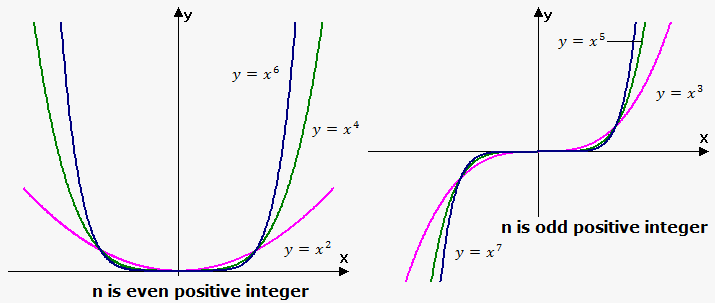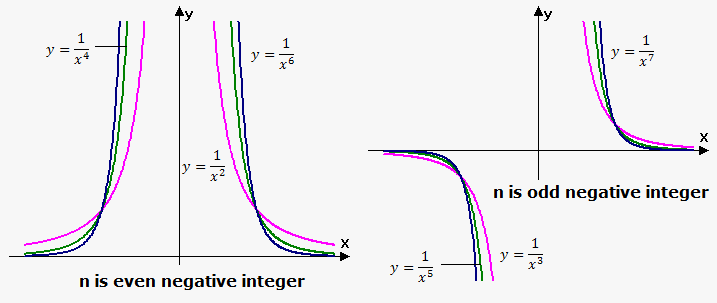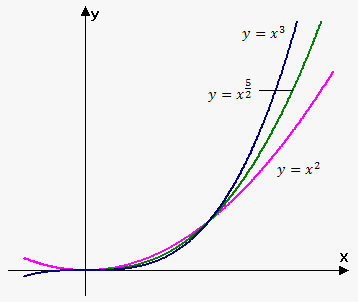Power Function
Function of the form $$${f{{\left({x}\right)}}}={{x}}^{{n}}$$$ where $$${n}$$$ is constant is called power function.
Depending on value of $$${n}$$$ graph of power function has different forms and properties.
Case 1: $$${n}$$$ is positive integer.
When $$${n}={1}$$$ we obtain line $$${y}={x}$$$. When $$${n}={2}$$$ we obtain parabola $$${y}={{x}}^{{2}}$$$. When $$${n}={3}$$$ we obtain cubic function $$${y}={{x}}^{{3}}$$$.
Graph of function depends on whether $$${n}$$$ is even or odd.
If $$${n}$$$ is even then functions of the form $$${f{{\left({x}\right)}}}={{x}}^{{n}}$$$ are even and their graphs are similar to the graph of function $$${y}={{x}}^{{2}}$$$.
If $$${n}$$$ is odd then functions of the form $$${f{{\left({x}\right)}}}={{x}}^{{n}}$$$ are odd and their graphs are similar to the graph of function $$${y}={{x}}^{{3}}$$$.
Note, that when $$${\left|{x}\right|}<{1}$$$ the bigger $$${n}$$$, the closer graph to x-axis. For $$${\left|{x}\right|}>{1}$$$ the bigger $$${n}$$$, the faster functions grows (the further from x-axis).
Case 2: $$${n}$$$ is negative integer, i.e. $$${n}=-{a}$$$ where $$${a}$$$ is positive integer.
Domain of such functions is all $$${x}$$$ except $$${x}={0}$$$ (function is nor defined when denominator equals 0).
When $$${n}={1}$$$ we obtain hyperbola $$${y}=\frac{{1}}{{x}}$$$.
Graph of function depends on whether $$${n}$$$ is even or odd.
If $$${n}$$$ is even then functions are even and their graphs are similar to the graph of function $$${y}=\frac{{1}}{{{x}}^{{2}}}$$$.
If $$${n}$$$ is odd then functions are odd and their graphs are similar to the graph of function $$${y}=\frac{{1}}{{x}}$$$.
Note, that when $$${\left|{x}\right|}<{1}$$$ the bigger $$${n}$$$, the furthe graph to x-axis. For $$${\left|{x}\right|}>{1}$$$ the bigger $$${n}$$$, the closer function to the x-axis.
Case 3: $$${n}$$$ is irreducible fraction, i.e. $$${n}=\frac{{a}}{{b}}$$$ where $$${a}$$$ and $$${b}$$$ are integers.
Domain of such functions depends on $$${a}$$$ and $$${b}$$$. Remember that we can't extract even-degree root of negative number.
First consider case when $$$\frac{{a}}{{b}}$$$ is positive.
In this case $$${{x}}^{{\frac{{a}}{{b}}}}={\sqrt[{{b}}]{{{{x}}^{{a}}}}}$$$. If b is odd then domain is interval $$${\left(-\infty,\infty\right)}$$$. If b is even then a is odd (remember that $$$\frac{{a}}{{b}}$$$ is irreducible, so $$${a}$$$ and $$${b}$$$ can't be both even) then domain is interval $$${\left[{0},+\infty\right)}$$$.
Now consider case when $$$\frac{{a}}{{b}}$$$ is negative, i.e. $$$\frac{{a}}{{b}}=-\frac{{m}}{{k}}$$$ where $$${m}$$$ and $$${k}$$$ are positive integers.
In this case $$${{x}}^{{\frac{{a}}{{b}}}}=\frac{{1}}{{{\sqrt[{{k}}]{{{{x}}^{{m}}}}}}}$$$. If k is odd then domain is interval $$${\left(-\infty,\infty\right)}$$$, except $$${x}={0}$$$. If k is even then m is odd (remember that $$$\frac{{m}}{{k}}$$$ is irreducible, so m and k can't be both even) then domain is interval $$${\left({0},+\infty\right)}$$$.

For example, domain of $$${y}={{x}}^{{\frac{{5}}{{2}}}}$$$ is $$${\left({0}+\infty\right)}$$$. Domain of the $$${y}={{x}}^{{-\frac{{5}}{{2}}}}$$$ is $$${\left({0}+\infty\right)}$$$.
For case when $$${n}$$$ is rational graph will lie between graphs of power functions with closest integer values.
For example, graph of the function $$${y}={{x}}^{{\frac{{5}}{{2}}}}$$$ will lie between graphs of functions $$${y}={{x}}^{{2}}$$$ and $$${y}={{x}}^{{3}}$$$ because $$${2}<\frac{{5}}{{2}}<{3}$$$. See figure to the left.
